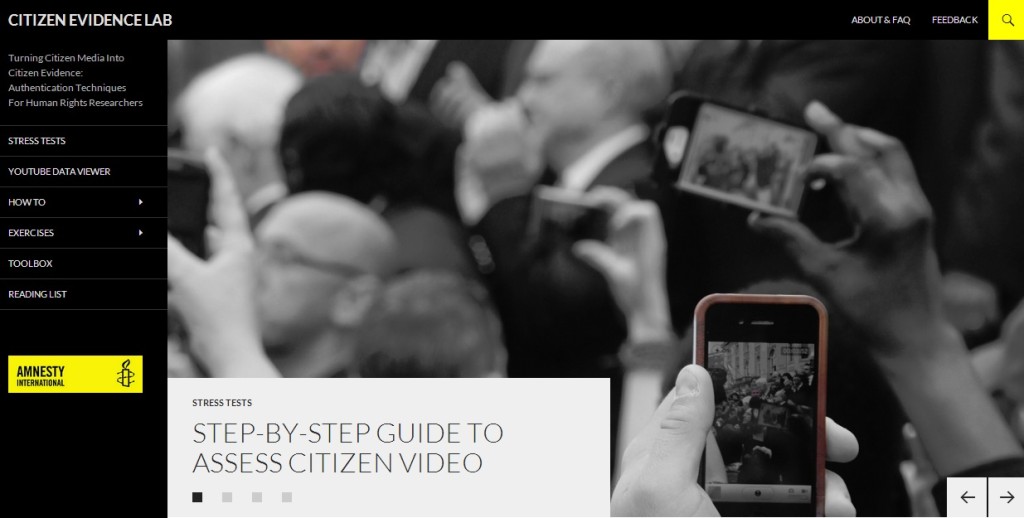During crises or disasters, YouTube is widely used to share footage – including a host of videos that are old or, in some cases, staged or faked. An enormous challenge for human rights workers, journalists or first responders alike is to separate fact from fiction. Now, there’s a website that can help.
The Citizen Evidence Lab – launched today – is the first dedicated verification resource for human rights workers, providing tools for speedy checks on YouTube videos as well as for more advanced assessment.
This is increasingly relevant for human rights organizations. Just last Friday, a video showing armed men shooting dead several men in their custody, reportedly in Syria, came across my desk. It had been uploaded to YouTube and shared on social media the previous day, 3 July. Using the Citizen Evidence Lab, it took me two minutes to determine that the footage was, in fact, old.
A few months earlier, a graphic video allegedly from South Sudan was circulated among human rights groups. It turned out that the same video was shared on YouTube several years earlier – with some claiming it was from Kenya and others saying it was from Myanmar.
In both these examples, a simple “reverse image search” of thumbnails of the videos – something that can now be done by anyone with our new DataViewer tool – unearthed previous versions of the footage. During crisis situations, speeding up the process of filtering out the old from the new is crucial.
However, we often have to do more in-depth research into footage. During the violent clashes in Cairo in August 2013, a video was widely shared that reportedly showed how protesters threw a police car off a bridge. Reviewing a second video showing the same incident from a different angle, it appeared that the police car had collided with another car, rolled back, and fell off the bridge. Additionally, the features seen in the videos—such as a soccer stadium next to the bridge—allowed me to confirm the exact location of the incident from my Washington, D.C. office by using online tools such as Google Earth.
Of course, checking for previous versions of the same video and confirming the location of an incident are only two steps in the verification process. A full list of steps and tools are now accessible through an interactive step-by-step guide – or a “Stress Test for YouTube videos“.
Game Changer
The torrent of video and images shared by ordinary citizens through digital social networks represents a game changer for my work. When I started at Amnesty International seven years ago, I worked with satellite images to gather scant information from inaccessible conflict zones.
Now, I am not only confronted with information overload, but also with a completely new level of detail. The opportunities and challenges stemming from this new media reality require novel skills and tools.
Through the Citizen Evidence Lab my intention is to share some of this work with a larger audience. Just as open source security software is considered safer because it gets tested and reviewed extensively, I hope to further improve our current verification process, to stay ahead of the people who spread misinformation during crisis.

Many thanks for this and for all the good work you do. This seems very valuable, even for volunteers to mention when we discuss violations in public; credibility is one of the hallmarks of AI.
It’s really a nice and useful piece of info.!! I’m glad that you shared this useful info with us.
Please keep us informed like this. Thanks 🙂
Thanks for this very informative post. There is lot to take in and lot to experiment. Keep going….Good work
great article
great article
This is a good way to find the real owner of the video! Good Stuff
Great info, thanks for sharing.
Thanks for the valuable insights. I have bookmarked the page and i find it very useful for me.
YES, this is the information that I had been wanting to read all day. I am so glad that you finally provided me with this information. I just hope that you don't stop here and keep on going with the same spirit.
Hi, Really great effort. Everyone must read this article. Thanks for sharing.
its really informative and helpful article,
keep it up admin and thanks for sharing such a cool and nice posts.
Its really Interesting information and helpful,
I want to visit again and again your website to see more post/articles thanks for sharing such a cool post.
Very well info
Nice article btw!!!